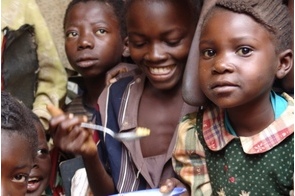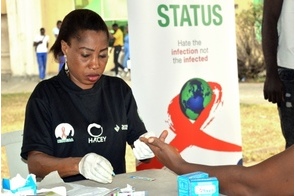Studies reveal gaping hole in health funding in Sub Saharan Africa

Summary
The research estimates that by 2040, average health spending per person will range from US$164 in low-income countries to US$9019 in high-income countries.
Two major studies, sponsored by the Bill & Melinda Gates Foundation and published in The Lancet, reveal the health financing crisis facing developing countries as a result of low domestic investment and stagnating international aid, which could leave millions of people without access to even the most basic health services.
Analysing national health spending and global health funding, two studies led by Dr. Joseph Dieleman from the Institute for Health Metrics and Evaluation (IHME), Seattle, USA, should be a wake up call to global leaders and governments to deliver greater investment in health.
"Despite tremendous need, our results show that tepid growth in health spending is likely in many of the poorest countries with the largest disease burdens over the next 25 years," says Dieleman. "Historically, some of these financing gaps have been filled by international aid. But, funding growth has stalled in recent years and future projections suggest that global health funding may not be sufficient to bridge the gap."
He adds, "These changes in the growth and focus of international aid could have a serious impact on over 15 million people taking antiretroviral therapy in developing countries and on health services in some low-income countries, particularly in sub-Saharan Africa where HIV/AIDS, tuberculosis, and malaria remain among the top threats to health."
The research estimates that by 2040, average health spending per person will range from US$164 in low-income countries to US$9019 in high-income countries, remaining lowest in sub-Saharan Africa in countries like Somalia (US$34), and highest in the USA (US$16592).
Many low-income countries are not expected to reach even the most basic globally agreed financing targets by 2040.
Even in 2040, governments in almost half (35 of 80) of low- and lower-middle-income countries studied will fall short of the US$86 per person spending target required to make essential health services universally available.
Only one low-income country (Rwanda) and around a third (36 of 98) of middle-income countries will meet the international target of governmental health spending reaching 5% of gross domestic product (GDP) by 2040.
Moreover, even after adjusting for purchasing power, the spending gap between low- and high-income countries is not expected to narrow, with low-income countries spending almost the same per person on health compared to high-income countries in 2040 as they did nearly 50 years ago -- equivalent to US$0.03 per person on health in the average low-income country for every dollar spent per person in the average high-income county in 1995, 2013, and 2040.
"For low- and middle-income countries to reach international spending targets and close the gap, domestic and international health funding will need to increase beyond historical growth rates," says Dieleman. "In low-income countries, on average $0.71 of international aid is provided for every $1 of domestic government funding, making it a critical resource."
Between 2000 and 2009, international aid increased at around 11% each year. However, since 2010 annual growth has been minimal (1.2%), with five consecutive years of little change in the amount of resources directed to developing countries to maintain and improve health at around US$35 billion.
Global health funding increased substantially after 2000, just as the United Nations established the Millennium Development Goals (MDGs). The majority of funding over the past 16 years, almost US$255 billion (around 60% of all international aid) has been focused on MDG-related health areas. Between 2000 and 2009, growth in aid was greatest for HIV/AIDS, malaria and tuberculosis. But since 2010, aid for maternal health and newborn and child health has slowed less than funding for other health focus areas, such as HIV/AIDS.
The model predicts that future international aid could vary widely, with an average estimate of about US$64 billion in 2040. But there remains large uncertainty about just how much funding will increase, with yearly growth rates ranging from -0.72 to 5.96%.
"The era of major growth in international aid for health has, at least temporarily, seemed to have ended. This may lead to substantial shifts in how global health is financed. Much will depend on how donors target their scarce resources and how governments fill gaps," says Dieleman. "Substantial variation between countries and across time, highlights the enormous potential for governments and donors to show their ongoing commitment to ensuring essential health services are affordable to those most in need."
In a linked Comment, Dr. Tim Evans at the World Bank Group, Washington, USA and Ariel Pablos-Méndez at the US Agency for International Development, Washington, USA, discuss how domestic and international funding for health can be sustained and increased as well as ensuring efficient use of available funding, writing that, "Resources for health can be raised by growing of government revenues through effective tax collection and combating of tax evasion… Prohealth subsidies targeted to the poor, such as conditional cash transfers, should be promoted, whereas ineffective subsidies (e.g., for fuel), which can exceed a country's spending on health, should be eliminated… [Also] an urgent need exists for innovations that direct private expenditure into prepaid pools; for example, through expansion of social health insurance towards informal sector workers and their families… The recent slowdown in development assistance for health growth also highlights the need to prioritize institutional capacity building and to develop plans that help countries ease the transition from grant to concessional and eventually self-financing."
They conclude, "While the challenge is daunting, attaining universal health coverage and its sustainable financing by 2030 is feasible for most countries. Success will depend on governments and partners aligning their objectives into a coordinated strategic effort."
Related
-
Policymakers meet in Tanzania to end global hidden hunger
"The Future Fortified Summit marks a significant moment for ending hidden hunger worldwide."
-
Access Bank sustains support for HIV/AIDs, NTDs interventions during Lagos marathon
Participants at the Access Bank's week-long Marathon Expo were also educated on NTDs, which also constitute a major public ...
-
China pledges to build 100 hospitals and clinics across Africa
China recently made a $5 million commitment to Gavi, the Vaccine Alliance.










